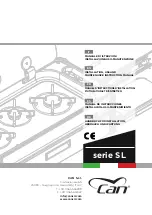
testing at test pressures less than to equal to 1/2 psig
(3.45 KPA), hot plate
must be isolated
from gas supply
piping. When pressure testing at test pressures above
1/2 psig (3,45 KPA), hot plate
must be disconnected
from gas supply piping system.
POSITIONING
The hot plate must be no closer than 6" from any
combustible material and 16" away from any open
flame. The hot plate must be placed under an exhaust
hood with a fire retardant system. Your ventilation hood,
when installed, must conform to the current ANSI/NFPA
96 standard.
ALL
connections and placement must
comply with local and national codes. It is the
responsibility of the owner and local installer to comply
with these regulations when installing the hot plate.
RESTRAINING DEVICES
Hot plates
must be restrained to prevent tipping
when installed in order to avoid splashing, spilling, etc.
of hot liquid. The restraining method may be a manner
of installation or by separate means. Adequate means
must also be provided to limit the movement of the
appliance without depending on the connector,the
quick-disconnect devise or its associated piping to limit
the appliance movement.
Connectors must comply with the current ANSI
Z21.69/CAN 1 6.10-88 standard for connectors for
movable gas appliances. Quick-disconnect devices
must comply with the current ANSI Z21.41/CAN 1 6.9-
M79 standard for quick-disconnect devices meet these
standards.
WARNING
PIPE JOINT COMPOUNDS RESISTANT TO
PROPANE GASES MUST BE USED.
BEFORE OPERATING THIS HOT PLATE, CHECK
PIPE JOINTS FOR LEAKS BY USING A SOAP
AND WATER SOLUTION ONLY. DO NOT USE AN
OPEN FLAME!
Figure 2-1
Main Gas Connection
FOR YOUR SAFETY: Do not store or use gasoline or
other flammable vapors and liquids in the vicinity of
this or any other appliance.
Connect the hot plate to the main gas supply line at the
rear of the hot plate. The piping should be a minimum of
3/4" IPS supply pipe for a single hot plate.
A 3/4" NPT manual gas valve is shipped with each
single hot plate for field installation. The required gas
pressure for proper operation of each hot plate is 4"
water column for natural gas and 10" water column for
Propane gas.
In-line pressure regulators are not supplied by Keating.
They are to be provided and installed by others as
directed by local codes.
NOTE:
If more than one gas hot plate is on the same
supply line, you may require a larger line. Consult your
local gas company to assure adequate volume and
pressure. Refer to serial plate for proper gas
requirements for your particular model.
ELECTRICAL CONNECTION
The Keating hot plate with an optional spark ignitor is
equipped with a 6' neoprene covered, 3 wire electrical
cord with a three-pronged grounded plug for protection
against electrical shock. This plug must be placed into a
120V properly grounded three-pronged outlet. For
proper grounding procedures see local codes or, in the
absence of local codes, the current National Electrical
Code ANSI/NFPA 70 or Canadian Electrical Code CAN
22.1 as applicable.
NOTE:
For hot plates with optional spark ignitors, the
electrical wiring diagram is located on the front of the
control panel. Hot plates with constant pilots do not
require any electrical connections.
WARNING
DO NOT CUT OR REMOVE THE GROUNDING
PRONG FROM THIS PLUG.
GAS LEAK TESTING
Prior to lighting your hot plate:
1.
Make sure all manual gas valves and gas valves
(infinite controls) are in the “OFF” (fully clockwise)
position.
2.
Turn main ON/OFF manual gas valve to the “ON”
position.
3.
Have your plumber or gas company check for leaks
with a soap solution. (NEVER check with a match!)
4.
Have your plumber or gas company representative
light the constant pilot. (Not necessary if your hot
plate has an optional spark ignitor.)
3































